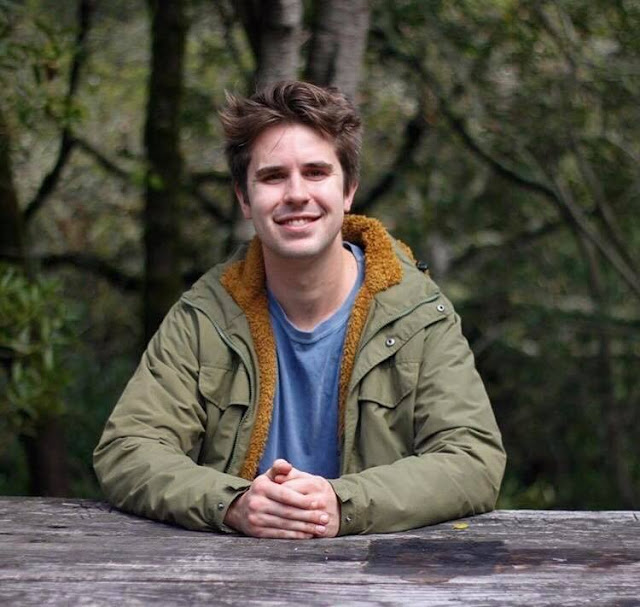Embrace the wild ...
Jimmy was in two of my classes, three if you count my interim class that he references below. He graduated in 2015.
He was something of the resident intellectual, the guy who seemed to know a little something about everything, whether we were talking about art or literature or politics or Celtic mythology. To this day, I can remember Jimmy dropping some knowledge during class about each of the following topics: color symbolism, the degradation of the rainforest, Freudian psychology and its limitations, geese formation and optimal wind resistance, Beat poetry, the relative differences between jackals and coyotes, and early 20th-century dadaism. When this first started happening in class, I was a little concerned because I didn’t want Jimmy to dominate the discussion. It didn’t take long for me to realize that the other students liked it. They were actually hungry for it. They listened carefully, even asked questions. “But what about the lead goose?” someone asked (we were talking about One Flew Over the Cuckoo’s Nest when Chief sees the geese flying over the ward). “How does the lead goose benefit from the V formation?” Jimmy: “They rotate … when the lead goose gets tired, he just drops to the right or left and lets another goose take over.”
One of his many interests is nature and wildness, and that’s what he writes about here. After graduating from high school, Jimmy went on to UC Berkeley where he has been studying Environmental Economics and Conservation and Resource Studies. He has also been involved with Shark Stewards, an NGO focusing on protecting sharks, and has spent time working at a grizzly bear sanctuary in Montana.
In his post, he looks at the concept of wilderness as something that is and should be part of our internal landscape and everyday lives. Wild is a state of mind. “My post is about learning that there is adventure in the seemingly mundane aspects of the human experience. We shouldn’t let archaic, romantic ideals get in the way of the truth of our personal wilderness.”
- C.H.
First of all, if you’re reading this and you aren’t a senior, make sure you take Mr. Harrington’s Nature, Writing and Solitude interim course. Pretty much all of what I learned or discovered during that class has stuck with me in the half-decade since I took it. One of the most important concepts I gleaned from that class was a romantic, almost religious, appreciation of the wild. However, I’m sure many of you that haven’t taken the class have experienced the same thing at one point of your life or another. And that’s because you don’t need to go to Idyllwild to experience some good old fashioned wild.
There’s an essay I read for a class my junior year at Berkeley called “The Trouble with Wilderness” by William Cronon. It’s a really interesting read because for a lot of environmentalists it’s a rude, provocative piece. Basically, the point Cronon is making is that the idea that wilderness is supposed to be an area free of people, far from cars and houses and factories, is one of the most problematic ideals of conservationists and romantics. Cronon asserts that there is just as much wilderness in a streetside Linda Vista puddle (I’m paraphrasing) as there is tumbling down the Yellowstone River.
I think a lot of people underestimate the amount of wilderness affects their daily lives and how often we have wild experiences. There’s not much difference between the wood in your coffee table and the old growth Washington forest from where it came. There’s not much difference between me working on a California burrito and a coyote getting his carne asada straight from the source. While I think it’s important to address the ways nature pervades our lives, I think there is arguably even more value in thinking about the ways we create and experience the wild in our lives without ever seeing a wolf or a pine tree.
Most of you reading this already have or are about to have a very innate experience with wilderness: college. I know this may sound cheesy, even trite, but college is a wilderness like none other. The experience of wilderness is a mix of awe, wonder, fear, and excitement. You’ll experience all those things in your first few weeks away at school. You’ll look at that senior crushing beers during rush week the same way you’d look at that moose hoovering riparian weeds. How is he consuming that much? I don’t know, but it is kinda cool, isn’t it?
I spent this past summer working outside of Bozeman, Montana, which is right north of the Greater Yellowstone. I remember on one trip to the Tetons, I was waiting at a trailhead for Aldo Lamberti (Class o’ 15) who was, per usual, a couple hours late. I got bored and decided my time would be better spent on the trail than in the parking lot. At first all was well, Grand Teton is quite beautiful, believe it or not. Then all of the sudden, I heard a crashing in the bush, about 40 feet away from me lumbered the massive brown frame of a Grizzly. I’m about 190 pounds, mostly beer fat (I’m no D1 athlete), but I felt about as small as a squirrel as soon as the big dude came into view. Looking back, I felt just as small walking into my first 400 person lecture at Cal. I guess the only difference, really, is you shouldn’t bring bear spray to class.





Comments
Post a Comment